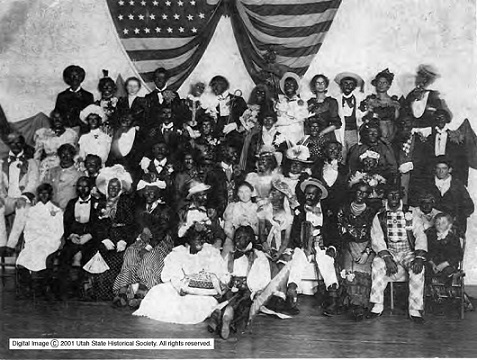Dublin Core
Title
Description
A newspaper article about a robbery reveals more than the story of a crime in Salt Lake City. It also tells us about the history of racism in Salt Lake City.
A little more than a century ago, a man was robbed on the streets of Salt Lake City. Hardly news, you'll probably say. Robbery's nothing new, even to the people of the late 1800s. But, what makes this story different is what it shows us about race relations in late-nineteenth-century Salt Lake.
According to the Salt Lake Tribune, the robbery victim was a traveling salesman named J. B. Phleger who, while on an evening walk, was accosted by an African American woman. “In the twinkling of an eye,” Phleger later remembered, the woman had grabbed his pocketbook, yanked out a twenty-dollar bill, and took off running down the street. The salesman quickly caught her, and held her until the police arrived. According to the Tribune, the woman was none other than Kit Hansen, a woman who was already well known to police.
The Tribune claimed that Hansen, when she was being taken away from the crime scene, began belting out the words to "Little Alabama Coon," a popular piece of music from the 1890s. The song probably came from the minstrel tradition, when white singers darkened their faces with burned cork and mocked African American cultural traditions. Its words are highly racist—referring to young black children as "pickanninies" and people of mixed ancestry as "yellow."
Why would Hansen sing such a racially-charged song? Well, I'm not sure she did. If we put the Tribune story into its historical context, we start to wonder if this was just the paper’s distasteful way of reinforcing racial prejudices that already existed in Utah’s capital city. You could find racism anywhere you looked in Utah at the end of the 1800s. Racial tensions bubbled just under the city's seemingly polite surface. In Kit Hansen’s case, the overt racial prejudice blacks often encountered when it came to housing, public accommodations, and employment spilled over into the pages of one of the state’s major newspapers.
Creator
Source
Image: Mercur, Utah. Minstrel show at Mercur, Utah. Actors in "black face" costume. Minstrel shows popularly featured white actors in blackface makeup singing racially charged songs mocking African Americans. These acts reinforced stereotypes that were used against the African American community in Utah. 1896. Courtesy of Utah State Historical Society.
_______________
See the news report of the robbery in the June 28, 1896, issue of the Salt Lake Tribune. Click the link for the text of the minstrel song, "Little Alabama Coon,” On the racial environment of Salt Lake City and Utah, see Ronald G. Coleman, “Blacks in Utah History: An Unknown Legacy,” in The Peoples of Utah, ed. Helen Z, Papanikolas (Salt Lake City: Utah State Historical Society, 1981), 115-140.

